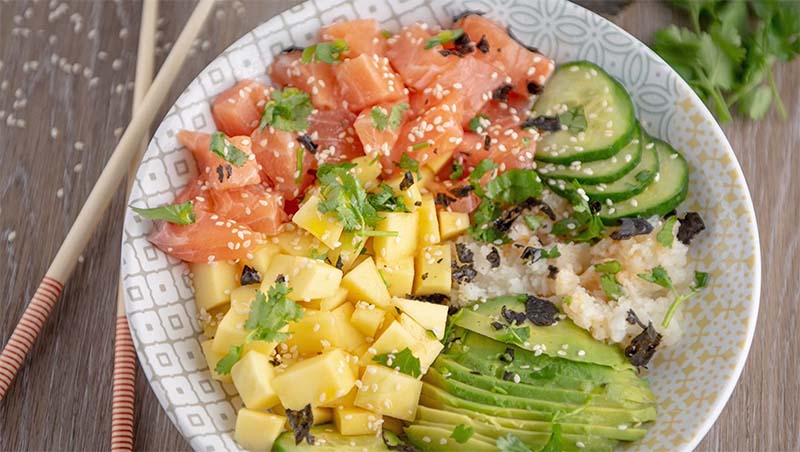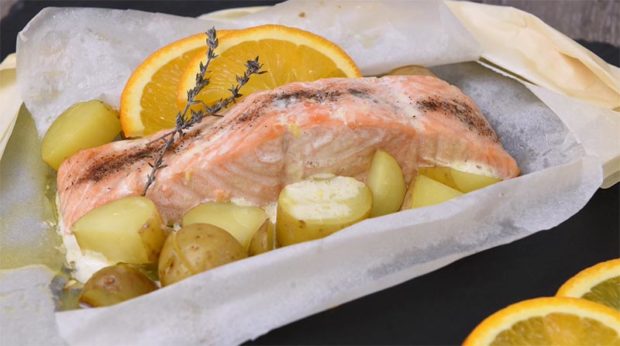For Dr Laura Wyness, ensuring that the advice she gives people about Their diet is evidence-based is vital. And the science shows that salmon Ticks all the right boxes.
“Salmon is a high-quality protein,” she explained, “and it is packed with vitamins, minerals and healthy fats that research has shown we all need to keep our minds and bodies working well.
“Surveys have shown that most of us aren’t eating enough fish.”
Experts like Dr Wyness recommend that people eat two portions of fish a week, one of which should be an oily fish, as part of a balanced diet.
However, “adults are only eating on average 56g of oily fish like salmon a week, which falls well below one portion, which is 140g,” she added.
Among the most important nutrients gained from eating salmon are omega-3 fatty acids. You shouldn’t be put off by the word ‘fatty’ as omega-3s are healthy fats that are beneficial to include in our diet.
“Salmon is one of the best sources of omega-3, which helps a number of parts of the body including the heart, brain and eyes. It’s also anti-inflammatory, so is great to alleviate muscle stiffness and promote recovery after exercise, which is why many athletes include it in their diet.
“Oily fish, such as salmon, is the best dietary source of vitamin D, which helps our bodies absorb calcium and improve bone health. Vitamin D also benefits heart health, the immune system and may help improve mood too.”
Everyone in the family can benefit from eating salmon regularly. Children get the vitamin D that helps them develop strong and healthy bones.
“Bone development continues right up into our 20s so having oily fish in the diet consistently throughout that time helps build strong bones.”
For mums and mums-to-be, omega-3 is important for the baby’s development in the womb and then while breastfeeding (although advice is to limit weekly amount to two portions of oily fish).
Meanwhile, older members of the family can help counter the effects of ageing, including women going through menopause.
“As we get older, our cognitive function and eyesight start to deteriorate. Salmon can be helpful at staving off those effects.
“As oestrogen levels fall after the menopause, cardiovascular disease risk increases. Salmon has several heart-healthy nutrients, including omega-3 fatty acids, which may also help alleviate menopausal symptoms.”
Adding more salmon to your diet is extremely easy – it’s great in stir-fries, stews and salads, or just simply grilled or baked and served with some veggies and a few potatoes.
Dr Wyness adds: “When I’m providing dietary advice to clients looking to lose weight, I often encourage them to include salmon as it provides quality protein to maintain muscle mass and curb their appetite, as well as a range of beneficial vitamins and minerals.
“It’s also easy to digest and there are many different ways it can be prepared without losing those nutrients.”
So if you’re looking for a tasty food that packs a nutritional punch, then think pink and pick salmon.
You can find out more about Scottish salmon farming, its importance to rural communities, the Scottish economy and how it can contribute to the green recovery – as well as the health benefits of eating fresh farmed salmon – on www.scottishsalmon.co.uk.
Scottish salmon, avocado, cucumber and mango pokebowl

Ingredients
(Serves 1 as a main meal, or 2 as a starter)
150g fresh Scottish salmon
½ mango
½ avocado
1 to 2 cups of cauliflower rice
1 tsp sesame oil
2 tbsp coconut milk
Ground ginger
Red chilli powder
Sesame seeds
1 sheet of Nori seaweed
Directions
Cut 150g of salmon into small cubes.
Mix 1 teaspoon of sesame oil and 2 tablespoons of coconut milk. Add 1 drizzle of olive oil, a little ground ginger and red chilli powder (to your own taste).
In a plate place 1 to 2 cups of cauliflower rice, half a sliced avocado and half a diced mango.
Arrange the salmon cubes with slices of fresh cucumber and sprinkle over with chopped coriander.
Pour over the sesame and coconut dressing and sprinkle with sesame seeds and chopped nori seaweed.
NOTE: This dish can be created with either raw or lightly seared Scottish salmon fillets.











